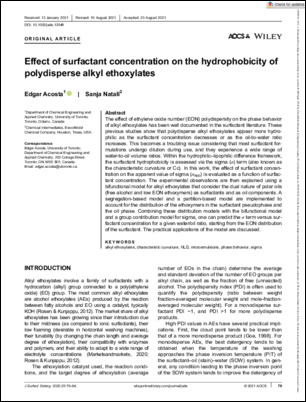Effect of surfactant concentration on the hydrophobicity of polydisperse alkyl ethoxylates
Abstract The effect of ethylene oxide number (EON) polydispersity on the phase behavior of alkyl ethoxylates has been well documented in the surfactant literature. These previous studies show that polydisperse alkyl ethoxylates appear more hydrophilic as the surfactant concentration decreases or as the oil-to-water ratio increases. This becomes a troubling issue considering that most surfactant formulations undergo dilution during use, and they experience a wide range of water-to-oil volume ratios. Within the hydrophilic–lipophilic difference framework, the surfactant hydrophobicity is assessed via the sigma (σ) term (also known as the characteristic curvature or Cc). In this work, the effect of surfactant concentration on the apparent value of sigma (σapp) is evaluated as a function of surfactant concentration. The experimental observations are then explained using a bifunctional model for alkyl ethoxylates that consider the dual nature of polar oils (free alcohol and low EON ethoxymers) as surfactants and as oil components. A segregation-based model and a partition-based model are implemented to account for the distribution of the ethoxymers in the surfactant pseudophase and the oil phase. Combining these distribution models with the bifunctional model and a group contribution model for sigma, one can predict the σ term versus surfactant concentration for a given water/oil ratio, starting from the EON distribution of the surfactant. The practical applications of the model are discussed.








